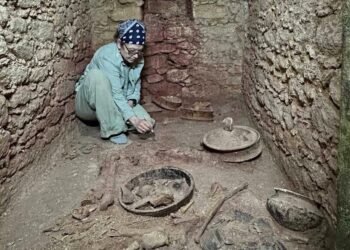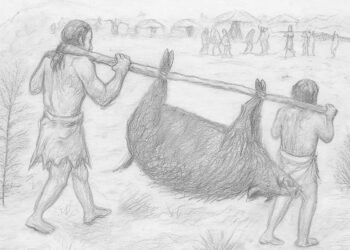Archaeologists and researchers from the University of Cambridge and Liverpool John Moores University have unveiled the reconstructed face of a 75,000-year-old Neanderthal woman.

The discovery, featured in the Netflix documentary “Secrets of the Neanderthals,” challenges previous perceptions of Neanderthals as brutish and unsophisticated.
The woman’s remains were dubbed Shanidar Z in reference to the cave located in Iraqi Kurdistan where her skull was discovered in 2018. The skull of Shanidar Z had been crushed into around 200 fragments, possibly by a rockfall soon after her death. Dr. Emma Pomeroy, a paleoanthropologist from the University of Cambridge, described the reconstruction process as akin to a “high-stakes 3D jigsaw puzzle.”
Despite the challenges, the team meticulously pieced together the fragments, strengthening them with a glue-like consolidant before removing them in small foil-wrapped blocks for further analysis. The reconstructed skull provided the basis for a lifelike facial reconstruction by renowned paleoartists Adrie and Alfons Kennis, revealing Shanidar Z’s appearance to the world.
The facial reconstruction suggests that Neanderthals may have been more similar to modern humans than previously thought. While Neanderthal skulls typically exhibit distinctive features such as pronounced brow ridges and lack of chins, Shanidar Z’s recreated face indicates that these differences may not have been as pronounced in life. This raises intriguing questions about the extent of interbreeding between Neanderthals and Homo sapiens, with Dr. Pomeroy noting that “almost everyone alive today still has Neanderthal DNA.”
The cave where she was discovered, Shanidar Cave, has been the site of significant archaeological discoveries, including evidence of deliberate burial practices among Neanderthals. While earlier interpretations suggested that Neanderthals may have buried their dead with flowers, recent research has cast doubt on this theory, proposing instead that pollinating bees may have brought in the pollen found among the graves.
The discoveries at Shanidar Cave underscore the complexity and sophistication of Neanderthal society. The positioning of the bodies in the cave, along with evidence of caring for individuals with disabilities, suggests a level of empathy and social organization among Neanderthals that challenges previous stereotypes of them as brutish and unsophisticated.
Professor Graeme Barker, who leads the excavations at Shanidar Cave, said that they “show that the Shanidar Neanderthals may have been thinking about death and its aftermath in ways not so very different from their closest evolutionary cousins — ourselves.”























